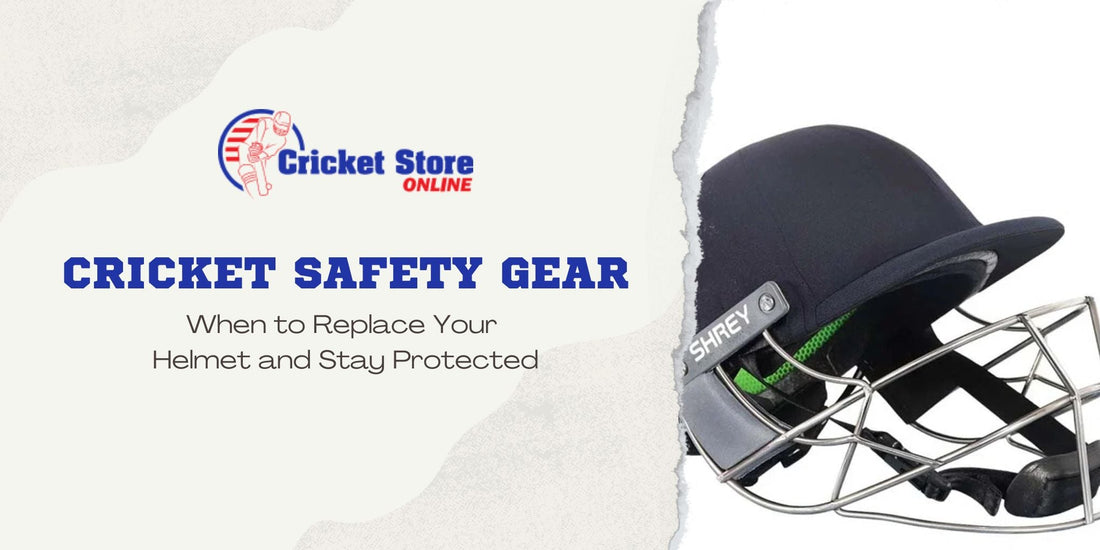Cricket Safety Gear: When to Replace Your Helmet and Stay Protected
Table of Contents
- Why Cricket Helmet Replacement is Critical for Player Safety
- Clear Warning Signs Your Cricket Helmet Needs Immediate Replacement
- How Often Should You Replace Your Cricket Safety Helmet?
- Understanding Cricket Helmet Safety Standards and Certifications
- Proper Cricket Helmet Care to Extend Protection Life
- Choosing the Right Replacement Cricket Safety Gear
- The Hidden Costs of Delaying Cricket Helmet Replacement
- Complete Cricket Safety Gear Replacement Checklist
Why Cricket Helmet Replacement is Critical for Player Safety
Cricket safety gear serves as your first and most important line of defense against potentially life-threatening head injuries. Modern cricket sees bowlers consistently delivering at speeds exceeding 90 mph, making proper head protection absolutely essential for batsmen, wicket-keepers, and close fielders alike.
The Role of Cricket Helmets in Head Injury Prevention
Cricket helmets are engineered to absorb and distribute impact energy across a wider surface area, significantly reducing the force transmitted to your skull and brain. The outer shell disperses initial impact, while the inner padding system cushions your head and prevents secondary impact injuries. However, these protective materials gradually deteriorate with age, exposure, and use.
Statistics on Cricket-Related Head Injuries
According to recent cricket safety studies, head injuries account for approximately 15% of all cricket-related injuries. More alarming is that 78% of serious head injuries occur when players are wearing helmets that are either outdated, improperly fitted, or showing signs of degradation. The tragic incidents involving professional cricketers like Phillip Hughes highlighted the critical importance of maintaining optimal protective equipment standards.
How Helmet Protection Deteriorates Over Time
Even without visible damage, cricket helmet materials undergo molecular changes that compromise their protective capabilities. UV exposure causes plastic shells to become brittle, while repeated minor impacts create micro-fractures invisible to the naked eye. The foam padding compresses over time, reducing its shock-absorbing properties by up to 40% after three years of regular use.
Clear Warning Signs Your Cricket Helmet Needs Immediate Replacement
Understanding when your cricket safety gear has reached the end of its protective life can literally save your life. Learn when to replace your cricket helmet by recognizing the key signs that it's time for an upgrade.
Visible Cracks and Structural Damage in Cricket Helmets
Immediate replacement indicators include any visible cracks in the helmet shell, regardless of size. These cracks act as stress concentrators, dramatically reducing the helmet's ability to distribute impact forces. Check for:
- Hairline cracks around the grille mounting points
- Spider web patterns on the shell surface
- Separated layers in the helmet construction
- Bent or damaged grille bars
- Loose mounting hardware
Even minor cracks can propagate rapidly under impact, turning what should be life-saving equipment into a dangerous liability.
Padding Deterioration and Fit Issues
The internal padding system is equally critical for protection. Warning signs include:
- Compressed foam that doesn't spring back when pressed
- Torn or missing padding pieces
- Loose helmet movement during normal head motion
- Pressure points causing discomfort
- Exposed hard surfaces touching your head
A properly fitted cricket helmet should feel snug but comfortable, with padding making contact around your entire head circumference. If you can fit more than one finger between the padding and your head, replacement is necessary.
Age-Related Helmet Degradation Signs
Time alone necessitates replacement, even with careful storage. Look for:
- Faded or discolored materials indicating UV damage
- Brittle chin straps that crack when flexed
- Musty odors suggesting moisture damage
- Warped shell shape from heat exposure
How Often Should You Replace Your Cricket Safety Helmet?
Cricket helmet replacement frequency depends on several factors, but manufacturer guidelines provide essential baseline recommendations that every player should follow.
Manufacturer Recommendations for Cricket Helmet Lifespan
Most reputable cricket helmet manufacturers recommend replacement every 3-5 years from the date of purchase, regardless of apparent condition. This timeline accounts for material degradation that occurs even with minimal use. Professional players often replace helmets annually due to intense usage demands.
Usage-Based Replacement Guidelines
Your replacement schedule should accelerate based on usage intensity:
| Player Level | Recommended Replacement |
|---|---|
| Professional/First-Class | Every 12-18 months |
| Club/League Regular | Every 2-3 years |
| Recreational/Occasional | Every 3-5 years |
| Junior Players | Every 2 years (growth factors) |
Professional vs. Amateur Player Considerations
Professional cricketers face higher-velocity bowling and more frequent impacts, necessitating more aggressive replacement schedules. Additionally, professional insurance requirements often mandate specific replacement intervals. Amateur players should consider their exposure level, with weekend warriors requiring less frequent replacement than daily net session participants.
Impact-based replacement applies regardless of timeline - any helmet receiving a significant impact should be professionally inspected or replaced immediately, as internal damage may not be visible.
Understanding Cricket Helmet Safety Standards and Certifications
Cricket helmet safety standards have evolved dramatically over recent decades, making older helmets potentially dangerous by today's requirements.
Current ICC and National Safety Standards for Cricket Helmets
The International Cricket Council (ICC) mandates that all helmets used in international cricket must comply with current safety standards. National cricket boards have adopted similar requirements for domestic competitions.
BS 7928:2013 Standard Requirements
The BS 7928:2013 British Standard represents the current gold standard for cricket helmet safety. This specification requires:
- Impact resistance testing at multiple points
- Penetration resistance from ball and stump impacts
- Retention system strength ensuring helmets stay secured
- Field of vision requirements for optimal gameplay
- Ventilation standards for player comfort
Why Outdated Safety Standards Put You at Risk
Helmets manufactured before 2013 may lack critical safety features now considered essential. Pre-BS 7928:2013 helmets often have:
- Inadequate grille protection allowing ball penetration
- Insufficient side impact protection
- Weaker shell materials that crack under modern bowling speeds
- Poor retention systems that fail during impact
"The difference between old and new safety standards isn't just technical specifications - it's the difference between basic protection and life-saving engineering." - Cricket Safety Equipment Specialist
Proper Cricket Helmet Care to Extend Protection Life
Maximizing your cricket helmet's protective lifespan requires consistent maintenance practices that preserve both structural integrity and hygiene standards.
Daily Maintenance for Cricket Safety Gear
After each use, implement this post-game inspection routine:
- Visual inspection for new cracks or damage
- Padding check for compression or separation
- Grille examination for bent bars or loose connections
- Strap testing for wear or stretching
- Ventilation clearing to prevent moisture buildup
Storage Best Practices for Helmet Longevity
Proper storage significantly extends helmet life:
- Temperature control: Store between 50-80°F to prevent material degradation
- Humidity management: Use moisture-absorbing packets in storage bags
- UV protection: Keep away from direct sunlight and fluorescent lighting
- Proper positioning: Store upright to prevent shell deformation
- Ventilation: Allow complete drying before storage
Cleaning Techniques That Preserve Helmet Integrity
Safe cleaning practices maintain hygiene without damaging protective materials:
- Use mild soap and warm water only
- Avoid harsh chemicals that can weaken plastic materials
- Remove padding for separate cleaning when possible
- Air dry completely before storage
- Never use heat sources for drying
Common mistakes that reduce helmet lifespan include leaving equipment in hot cars, using aggressive cleaning products, and storing while damp.
Choosing the Right Replacement Cricket Safety Gear
Selecting optimal replacement cricket helmets requires understanding modern technologies and ensuring proper fit for maximum protection.
Modern Cricket Helmet Features and Technologies
Contemporary cricket helmet innovations include:
- Multi-impact foam systems that maintain protection after minor impacts
- Advanced ventilation designs improving comfort without compromising safety
- Lightweight composite materials reducing neck strain
- Adjustable retention systems for secure, comfortable fit
- Enhanced grille designs providing superior protection and visibility
Fitting Your New Cricket Helmet Properly
Proper helmet fitting is crucial for optimal protection:
- Measure head circumference at the widest point
- Try multiple sizes as brands vary
- Check for pressure points during extended wear
- Ensure grille positioning doesn't obstruct vision
- Test retention system security during movement
The helmet should feel snug but not tight, with padding making even contact around your head. Movement should be minimal when shaking your head vigorously.
Budget Considerations for Quality Cricket Safety Gear
Investment in quality cricket helmets pays dividends in protection and longevity:
| Price Range | Expected Features | Typical Lifespan |
|---|---|---|
| Budget ($50-100) | Basic protection, limited adjustability | 2-3 years |
| Mid-range ($100-200) | Good materials, better ventilation | 3-4 years |
| Premium ($200+) | Advanced materials, superior comfort | 4-5 years |
Never compromise on safety standards to save money - a properly certified budget helmet offers better protection than an expensive non-compliant model.
The Hidden Costs of Delaying Cricket Helmet Replacement
Postponing necessary helmet replacement creates financial and personal risks far exceeding replacement costs.
Medical Costs of Cricket Head Injuries
Head injury treatment expenses can be catastrophic:
- Emergency room visits: $1,000-5,000
- Concussion treatment: $5,000-15,000
- Serious brain injury care: $50,000-500,000+
- Long-term rehabilitation: Potentially millions
Insurance and Liability Issues with Outdated Safety Gear
Insurance complications often arise when injuries occur while using non-compliant or outdated equipment. Claims may be denied or reduced when safety standards aren't met. Coaches and club officials face potential liability when allowing players to use substandard protective gear.
The career impact of preventable head injuries extends beyond immediate medical costs, potentially ending playing careers and affecting long-term earning capacity.
Complete Cricket Safety Gear Replacement Checklist
Monthly Cricket Helmet Inspection Routine
Implement this comprehensive monthly inspection:
External Inspection:
- [ ] Shell integrity (cracks, deformation)
- [ ] Grille condition (bent bars, loose connections)
- [ ] Hardware security (screws, rivets)
- [ ] Strap condition (fraying, stretching)
Internal Assessment:
- [ ] Padding compression test
- [ ] Fitting evaluation
- [ ] Comfort assessment
- [ ] Moisture damage check
Documentation:
- [ ] Record inspection date
- [ ] Note any concerns
- [ ] Track replacement timeline
- [ ] Schedule professional assessment if needed
When to Consult Cricket Safety Gear Experts
Professional assessment is recommended when:
- Helmet has received significant impact
- Inspection reveals potential issues
- Player experiences discomfort or fit problems
- Uncertainty about compliance with current standards
Key takeaway: Your cricket helmet is your most important piece of safety equipment. Regular inspection, proper maintenance, and timely replacement ensure optimal protection throughout your cricket career. Don't gamble with your safety - when in doubt, replace your helmet and stay protected on the cricket field.
Remember: A new helmet costs far less than a single emergency room visit, making timely replacement both a safety imperative and a smart financial decision.


